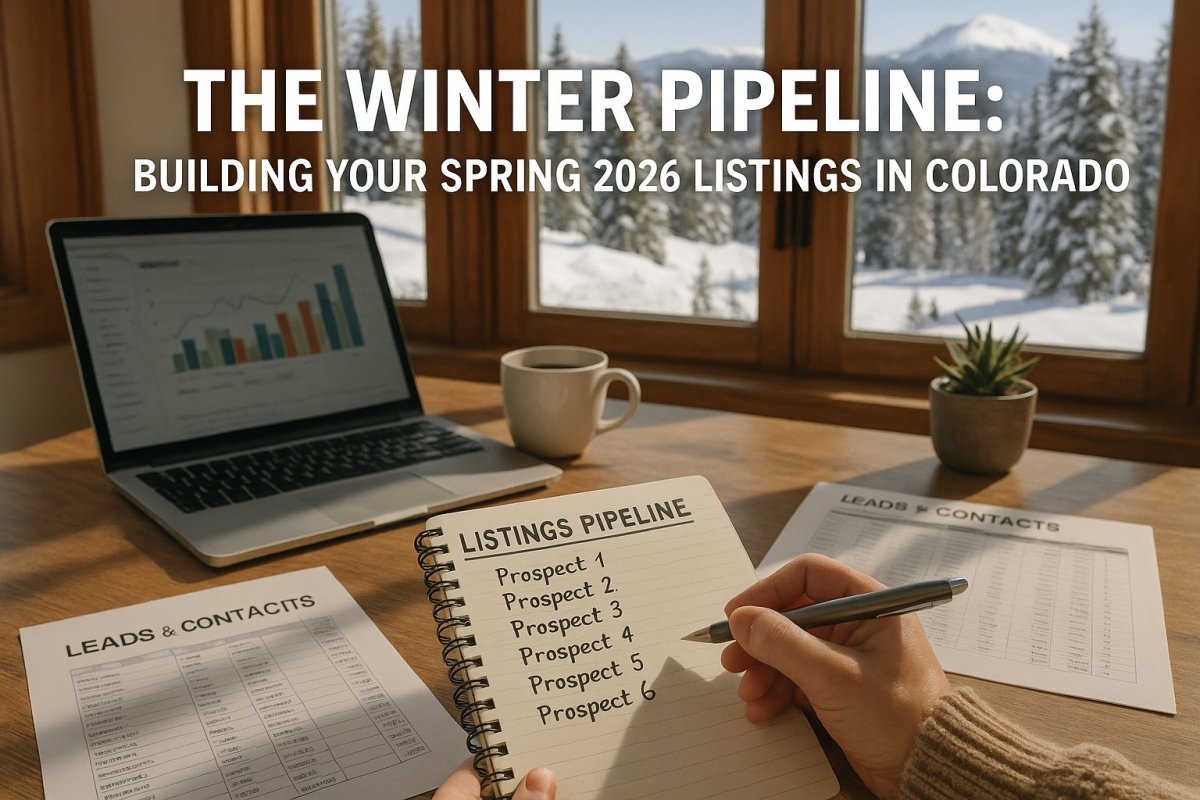The "Life Event Executor" is a seller profile for a person, often an out-of-state heir, who has inherited a property and is motivated by the need to efficiently liquidate the asset and close an estate.
Executive Summary: Few listings demand more professionalism—or reward it more—than estate sales where the personal representative (PR) lives in another state. Out-of-state heirs value certainty, speed, and dignity above everything else. They are juggling flights, jobs, attorneys, siblings with opinions, and a vacant house 1,000 miles away that still needs insurance, utilities, and winterization. If you can remove friction, communicate clearly, and present transparent choices—a quick cash disposition or an MLS strategy with modest make-ready—you will convert these sellers at a high rate and earn lifelong referral partners in trusts & estates circles. This long-form playbook is a Colorado-specific field guide: persona, process, math, micro-markets, scripts, vendor bench, risk controls, and weekly KPIs. Use it with our guides on the "Locked-In Effect," building the "Winter Pipeline," "Mastering Micro-Markets," the "2026 Colorado Housing Outlook," identifying sellers from the "HELOC Squeeze," and serving "Trapped Equity Downsizers" to run a cohesive seller system in 2026.
1) Meet the persona: the Out-of-State Heir / Personal Representative (PR)
Most estate listings you win will start with one of these profiles:
- The Organized PR: Has counsel, letters of appointment, and a strong bias toward project management. Wants a single point of contact who can coordinate vendors and weekly updates.
- The Overwhelmed Sibling: Flies in once, discovers 30 years of belongings, and feels stuck between “sell now” and “make it perfect.” Needs clarity and emotional safety.
- The Remote Executor: Lives on the coasts, has limited time off, and wants “one trip, one closing.” Prefers certainty over squeezing every dollar.
- The Disagreeing Heirs: Multiple beneficiaries, uneven sentimental ties, competing advice. You become the translator who reframes decisions with neutral math.
What they all want: empathy, a plan, documented options, predictable timelines, and a pro who solves problems without drama.
2) Colorado probate basics (non-legal overview)
Disclaimer: The following is for general understanding only and not legal advice. Always refer PRs to their attorney for legal questions.
- Typical participants: Personal Representative (PR/executor), attorney, title/escrow, real estate agent, sometimes a fiduciary or conservator.
- Key documents you'll see: Death certificate, Letters of Appointment/Letters Testamentary or Letters of Administration, PR deed authority, and, if relevant, trust certifications.
- Practical sequence (simplified): Appointment of PR → inventory/valuation → disposition decisions (keep, distribute, or sell) → marketing/listing → contract → court/attorney review if required → close → proceeds distribution.
- Timing: Varies widely. Your value is to compress the real estate portion via readiness (vendors lined up), clear decisions, and early title work.
As the agent, your lane is logistics, market strategy, and net proceeds clarity—not legal interpretation. Communicate that respectfully and consistently.
3) Why out-of-state heirs are motivated sellers
These sellers are “motivated” for reasons distinct from typical homeowners:
- Distance & logistics: Every task is harder when you live in another state. A single decision can require flights, rental cars, and schedule juggling.
- Carrying costs & risk: Vacant homes still accrue utilities, taxes, insurance, possible HOA dues/assessments—and vacancy risks (leaks, vandalism, freeze damage).
- Insurance & liability: Some policies treat long-term vacancy as a different risk class; heirs want to exit cleanly and quickly.
- Family dynamics: PRs want a plan that minimizes conflict and creates a fair, documented record of decisions.
- Emotional closure: Most heirs want to honor a loved one while moving the estate forward. Certainty becomes the ultimate service.
When you understand these drivers, your value proposition becomes obvious: certainty plus dignity.
Because the motivation is driven by logistics and the need to settle the estate, traditional market timing is less of a concern. However, understanding seasonal trends can still be beneficial, as detailed in our guide to the best time to sell in Colorado.
4) The two-path disposition memo (your signature tool)
From your first meeting, present a one-page, side-by-side “Two-Path Memo” that documents the choices:
| Dimension | Path A — Cash / As-Is | Path B — MLS After Light Make-Ready |
|---|---|---|
| Timeline to Closing | 10–21 days typical (as-is) | 3–6 weeks prep + DOM band by micro-market |
| Upfront Work | Minimal (clean-out only) | Vendor sprint: clean-out, paint, flooring, minor repairs, staging |
| Carrying Costs & Risk | Low (short exposure) | Medium (vacancy + market time) |
| Price / Net | Lower gross; reduced friction | Higher gross; costs deducted; higher net likely in balanced/tight cells |
| Certainty | High (investor terms) | Moderate–High (pre-vetted offers; transparent comps) |
| Decision Control | Single decision fast | Multiple vendor + pricing decisions (you manage) |
Heirs appreciate seeing choices in writing. Your neutrality builds trust, even when your recommendation is MLS. Pair the memo with a preliminary net proceeds worksheet for each path.
5) The math that moves decisions: net proceeds & carrying costs
Use conservative numbers and show your work. Here’s a template you can tailor to the property and micro-market (see our guide on "Mastering Micro-Markets" for cell-by-cell calibration).
| Line Item | Path A — Cash / As-Is | Path B — MLS (Light Make-Ready) | Notes |
|---|---|---|---|
| Expected Contract Price | $X (investor) | $X + $30–$80k (market) | Range depends on cell/condition |
| Make-Ready Budget | $0–$2k (clean-out only) | $8–$25k (paint/floor/light repairs) | Keep scope tight; ROI focused |
| Carrying Costs (30–60 days) | $0.8–$1.6k | $1.6–$3.2k | Taxes, utilities, HOA, insurance |
| Concessions/Buyer Credits | None (typical) | $5–$12k (payment relief) | Use credits vs. broad price cuts |
| Estimated Net | $NA | $NB (usually higher in balanced/tight cells) | Show low/med/high outcomes |
When heirs see realistic ranges, they decide faster—and appreciate your transparency. In condo/TH corridors with higher dues or assessments, plan for buyer credits and make HOA disclosures up front.
6) Micro-market nuance across the Front Range
Estate-sale strategy must fit the local cell (ZIP + property type + school zone + HOA/insurance context). Three common patterns:
A) Denver Metro — Detached Family Homes in Established Subdivisions
- What works: Light make-ready (paint, floors, yard), pre-inspection transparency, price to last 60–90 days, modest buyer credits if needed.
- Narrative: Family-ready + functional utility (bed/bath count, yard, garage). Launch windows matter (see our "Winter Pipeline" playbook).
- Risk: Over-scoping updates. Keep ROI tight.
B) Urban Condo/TH Corridors (Downtown, DTC, parts of Aurora)
- What works: Total-cost transparency (dues, assessments, insurance). Expect concessions; deploy targeted buyer credits or buydowns.
- Narrative: Convenience and location; turn-key after light refresh. Disclose building strengths (reserves, recent capex).
- Risk: Financing hurdles in specific buildings; verify early.
C) Colorado Springs & Northern Colorado — Ranch Belts and Mid-Century Parcels
- What works (Springs): Assumability checks on VA loans; certainty-heavy messaging for PCS calendars.
- What works (NoCo): Concierge clean-out; simple cosmetic lift; education on wells/septic where relevant.
- Narrative: “Clean, safe, ready”—buyers reward easy transitions in these cells.
7) The vendor bench: your estate-sale concierge
Build (and publish) a written vendor map you can hand to PRs. It turns anxiety into a plan.
| Category | Scope | Why It Matters |
|---|---|---|
| Clean-Out & Donation | Sort, haul, receipts, sensitive document handling | Reduces PR travel; speeds readiness |
| Estate Sale / Appraiser | Value personal property; run sale if needed | Defuses heir disputes with documentation |
| Locksmith / Security | Rekey, smart lock, vacancy checks | Vacant risk control |
| Preservation / Winterization | Furnace set, water off, leak sensors | Insurance comfort; loss prevention |
| Handyman / Paint / Flooring | Punch list, cosmetic refresh | Highest ROI in most estates |
| Stager / Photographer | Light stage; emphasize function | Speed and price support |
8) Scripts (compassion-forward, math-backed)
Condolence + Service Letter (Day 0–3):
“I’m sorry for your loss. Handling a home from another state is hard. My team manages everything—clean-out, minor fixes, photography, showings, and weekly progress updates—so you can focus on family. When you’re ready, I can send a one-page comparison of a quick as-is sale vs. light make-ready + MLS, with estimated timelines and net ranges.”
Phone Opener (PR Already Appointed):
“My role is logistics and clarity. I’ll show you two paths in writing. If you choose MLS, I coordinate vendors and oversee everything. If you choose a fast sale, I’ll assemble clean offers with verifiable funds. Either way, you have weekly updates and one point of contact.”
Sibling Alignment (Group Call):
“I’ll put both options side by side with conservative math and a week-by-week schedule. That way, you can choose the path that fits everyone’s bandwidth, not just the highest headline price.”
9) Intake checklist (estate edition)
Pro Tip: Download this as a printable PDF checklist for your records.
- Confirm PR authority (letters), contact for attorney/title, any court requirements.
- Occupancy & security status; key exchange plan; rekey order.
- Insurance and vacancy guidance (PR to confirm with carrier).
- Utilities on/off & winterization checklist.
- Personal property plan: hold, donate, sell; schedule appraiser if needed.
- Make-ready scope (light, ROI-focused) and budget cap.
- Preliminary title order (early is better for estates/trusts).
10) Production timeline (estate MLS path)
- Week 1: Rekey, clean-out plan, title open, pre-photo punch list, insurance check, vendor dates reserved.
- Week 2: Clean-out executes; paint/floor refresh; exterior tidy; photo scheduled.
- Week 3: Photography, copy, disclosures assembled (estate status, any known condition items), lockbox and showing plan.
- Week 4: Go live; showings start; weekly update cadence; review feedback and adjust credits if needed.
Shorten or lengthen based on the micro-market cell (see "Mastering Micro-Markets") and the property type.
11) Pricing strategy by asset
- Detached (family-ready): Price to live comps; emphasize function and condition improvements. Keep concessions light unless DOM passes the local median.
- Condo/TH: Make HOA/insurance transparency central. Use targeted credits or buydowns to solve buyer payment pain.
- Unique / acreage: Set realistic DOM bands; provide buyer education packets (water/septic where relevant); aerials and outbuilding narratives.
12) Objections & answers (with respect)
“We don’t want to deal with repairs.”
“Understood. We can list as-is and reflect that in pricing, or we can do the minimum high-ROI refresh to improve your net. I’ll cap scope and manage vendors so you have one invoice and one schedule.”
“One sibling wants to hold the house.”
“I’ll document both paths with timelines and estimated nets. That helps families make decisions without guesswork. If you choose to hold, I’ll connect you with a property manager and insurance guidance.”
“We’re worried about leaving valuables behind.”
“We rekey immediately, catalog with photos, and can arrange an appraiser or estate sale pro. I’ll keep a chain-of-custody checklist in your weekly updates.”
13) Compliance & ethics (protect the family and your license)
- Neutrality in offers: Present investor and retail offers with the same care. Avoid self-dealing and dual-agency conflicts; disclose relationships.
- Truth in advertising: Avoid guarantees; present ranges and scenarios. Don’t imply legal advice.
- Fair housing: Keep marketing focused on property utility and facts. Avoid sensitive targeting.
- Documentation: Two-path memos, net sheets, vendor receipts, weekly progress emails—these reduce intra-family conflict and protect you.
14) Case studies (Front Range estates)
Case A — Denver Bungalow (PR in California)
Condition: dated kitchen/bath; good bones; walkable block. We proposed $14k make-ready (paint, floors, lighting). Go-live three weeks later. Result: 9 showings first weekend, 3 offers, modest buyer credit; closed in 28 days. PR made one trip; everything else handled via weekly photos and DocuSign.
Case B — Colorado Springs Ranch (PR in Texas)
VA assumable first discovered in intake; marketed assumability benefit. Two-path memo favored MLS due to tight absorption. Result: buyer used assumability; smooth inspection with pre-inspection transparency; rent-back allowed PR to coordinate personal property locally once.
Case C — Fort Collins Mid-Century (PR in Illinois, siblings split)
Sibling disagreement resolved by math: As-is investor offer net vs. MLS net with a capped $9k refresh. Estate chose MLS; we provided chain-of-custody logs for valuables and a clean-out receipt packet. Closed in 35 days; post-closing, PR sent two referrals.
15) Outreach cadence (winter → spring)
As detailed in our "Winter Pipeline" guide, the quiet months are decisive for estate sales.
- December: Build your contact base: probate counsel intros, title partners, CPA firms. Mail a Condolence & Service letter to PRs (where appropriate and allowed) focusing on logistics, not solicitation.
- January: Host a 30-minute webinar: “Selling a Colorado Estate from Out of State—Two Paths, One Plan.” Provide a one-page handout.
- February: Offer complimentary Two-Path Memos with preliminary net ranges; line up vendor sprints so March listings can hit spring demand.
16) KPIs (run your estate pipeline like a practice)
- Time from PR contact → Two-Path Memo delivered: Target <72 hours.
- Memo → Signed Listing conversion: 40–60% when math is clear and vendor plan is ready.
- Signed Listing → Live: Median 14–28 days for light make-ready.
- Live → Mutual: Track by cell; detached family homes in balanced/tight cells should see offers within 7–21 days when priced to live comps.
- Variance to list price: Aim for 98–101% depending on cell and concessions prevalence.
- Travel minimization: # of PR trips required (target ≤1).
17) Integrating TimeToSell.AI (from persona to precise targets)
Use TimeToSell.AI to surface likely estate/PR scenarios based on deed changes, mailing address shifts, tenure, and other public signals. Combine with your "Mastering Micro-Markets" score to prioritize cells. Then:
- Send compassion-first outreach to top 100–200 leads within green cells.
- Offer a same-day Two-Path Memo with conservative ranges.
- Commit to weekly progress updates, vendor coordination, and early title work to compress timeline.
Pair this with our guides on "How to Find Trapped Equity Downsizers" (for inherited homes that heirs move into temporarily and later sell) and "The HELOC Squeeze" (rare overlap where estates carry seconds).
18) Risk matrix (what can derail a smooth estate sale)
| Risk | Impact | Mitigation |
|---|---|---|
| Title complexity (liens, trusts, multiple heirs) | Delay or failed closing | Open title early; attorney coordination; PR authority docs on file |
| Vacancy damage (freeze/leak) | Cost, delays | Winterization; leak sensors; regular checks |
| Financing hurdles (condo) | Buyer fallout | Verify building financeability upfront; price/credit strategy |
| Family conflict | Indecision | Two-Path Memo; group calls; documented updates |
| Scope creep in make-ready | Budget/time blowout | Cap scope; ROI-only updates; single point of approval |
19) Marketing that respects the moment
- Honest copy: “Estate sale—lightly refreshed, sold as-is with disclosures” is better than hype.
- Function over flourish: Buyers of estate homes value clean, safe, and ready more than designer finishes.
- Visuals: Professional photography that emphasizes light, storage, and functional rooms; aerials when lot value matters.
- Payment framing: In condo/TH, show how targeted credits/2-1 buydowns affect buyer monthly—see our guide on "The HELOC Squeeze".
20) 30/60/90-day operating plan (estate listing practice)
- Days 0–30: Build referral channels (probate attorneys, CPAs, wealth managers). Draft your Two-Path Memo template and net sheet calculator. Assemble vendor bench with service-level agreements.
- Days 31–60: Launch a short webinar for PRs; publish a “Colorado Estate Sale: Two Clear Paths” PDF. Start a monthly Estate Market Brief with micro-market stats and case studies.
- Days 61–90: Run your first 10 PR engagements end to end; measure KPIs; refine timelines; gather testimonials (with permission); update your internal playbook.
21) Pulling it together
Out-of-state heirs aren’t shopping for slogans; they are shopping for certainty and care. Your job is to deliver a choice architecture (Two-Path Memo), a compressed timeline (vendor bench + weekly updates), and math that de-escalates family decisions. This is where a modern agent earns trust swiftly and keeps it. For broader market context and timing, revisit our "2026 Colorado Housing Outlook" and "The Winter Pipeline." For micro-execution in Denver Metro, apply the frameworks in our guide on "Mastering Micro-Markets."
Final word: The best estate agents in Colorado make one promise and keep it: “We will move your family from uncertainty to clarity.” Lead with empathy, document choices, manage every vendor, and show conservative net math. Do that, and you will earn listings now and referrals for years. Activate your free TimeToSell.AI account to pull a targeted list of likely PRs and estates in your farm, and use your $100 voucher to launch your outreach sequence this week.





